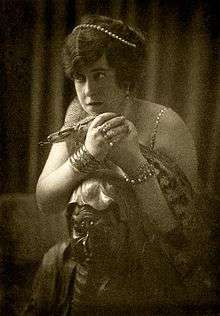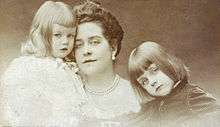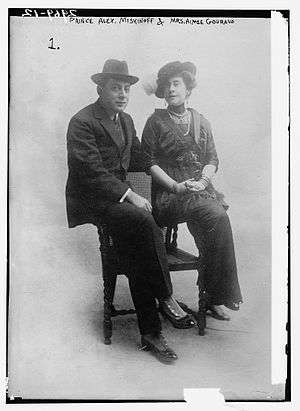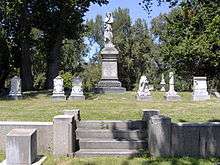Aimée Crocker
| Aimée Crocker | |
|---|---|
 Aimée Crocker circa 1890 | |
| Born |
Amy Isabella Crocker December 5, 1864 Sacramento, California, U.S. |
| Died |
February 7, 1941 (aged 78) New York City, New York, U.S. |
| Other names | Princess Aimée Isabella Crocker Ashe Gillig Gouraud Miskinoff Galitzine |
| Spouse(s) |
Richard Porter Ashe (m. 1882–87) Henry Mansfield Gillig (m. 1889–1900) Jackson Gouraud (m. 1901–10) Alexander Miskinoff (m. 1914–16) Prince Mstislav Galitzine, Count Ostermann (m. 1925–27) |
| Children |
Gladys (b. 11-21-84) Reginald (b. 3-31-97) Yvonne (b. 5-1-99) Dolores (b. 7-20-06) Yolanda (b. 6-15) |
Aimée Crocker (December 5, 1864 – February 7, 1941) was an American heiress, princess, Bohemian, world traveler, mystic and author. She was known for her cultural exploration of the Far East, for her extravagant parties in San Francisco, New York and Paris, and for her collections of lovers, adopted children, Buddhas, pearls, tattoos and snakes.
Biography
Family
Aimée Crocker was born Amy Isabella Crocker December 5, 1864 in Sacramento, California to Judge Edwin B. Crocker and his second wife Margaret.
Aimée's father was the chief legal counsel for the Central Pacific Railroad and was one of its principal investors along with Mark Hopkins, Collis Huntington, Leland Stanford and brother Charles Crocker, also known as The Big Four. Together they built the western portion of the world’s First Transcontinental Railroad. Edwin served briefly as a California Chief Justice. Aimée's mother is also known for founding Sacramento’s Crocker Art Museum, the longest continuously operating art museum in the West with, for a time, the largest private collection in the country.
Aimée was the first cousin of William Henry Crocker, humanitarian and president of three great West Coast institutions: the Crocker Bank (once the 14th largest bank in the nation), the University of California, and the California Academy of Sciences. When much of the city of San Francisco was destroyed by the fire from the 1906 earthquake, William Crocker and his bank were major forces in financing reconstruction. Wife Ethel Crocker was the leading, if not the only, California patron of French Impressionist art at the time, owning paintings by Claude Monet, Eugène Boudin, Camille Pissarro, Pierre-Auguste Renoir, and Edgar Degas.
Aimée's grandson Gerald Russell was a naturalist, an adventurer and a cryptozoologist who joined several very well publicized expeditions including the Percy Sladen expedition to Africa, where in the high forests of the British Cameroons, he reportedly encountered a large unclassified animal Mokèlé-mbèmbé. While in the Assumbo Mountains, he witnessed the over flight of a giant batlike creature known as the Olitiau. In 1936, Russell joined the Ruth Harkness Asiatic Expedition to Tibet. They were the first to successfully capture the then elusive, almost mythical beisung [giant panda]. In 1958 Russell was selected to lead the Slick-Johnson Snowman Expedition to Nepal, during which his guide claimed to have actually seen a Teh-lma, which is the smallest type of Yeti, in the upper Arun Valley of Nepal.
Early years
Aimée Crocker was the sixth child in a family of four girls, two boys, and a half sister. Three of the children would die young. Aimée was left with a fortune of $10 million in 1875 ($196 million in 2010 dollars), when her father "E.B" died.[1][2] Two years later, her mother Margaret decided to send the precocious young girl to a finishing school in Dresden, Germany. There she was presented at court and had her first love affair and engagement with Prince Alexander of Saxe Weimar.[3] Aimée broke the engagement and followed up that romance with a brief entanglement with a Spanish bullfighter.
Aimée hit the national stage in 1883, when traveling to Los Angeles on her honeymoon with first husband, Porter Ashe. The train carrying the eloping couple broke loose at the summit of a hill in Tehachapi, killing 21 people and seriously injuring another 12. Aimée’s young husband, whose forefathers had given their name to Asheville, North Carolina and whose uncle was the great Civil War Admiral David Farragut,[4] was credited with pulling people to safety. According to a front page New York Times report Ashe, “exhibited a great deal of cool heroism at the burning of the cars. After drawing his wife and her maid through the window of the sleeper, he rescued ex-California Governor John G. Downey from between broken timbers, and saved his life.”[5]
Not long after the birth of their daughter Gladys (aka "Alma") Aimée’s marriage collapsed. Porter plunged into a score of speculations, none of which proved successful. He spent a small fortune on horse racing studs, and then sold off many of them to settle gambling debts. Porter became a patron of prize-fighters, and began to dance attendance upon the latest favorite of the ballet or the comic opera. His friendships with actresses Lillie Langtry and Lotta Crabtree were the source of much gossip.[6] Aimée was herself seen everywhere at fashionable entertainments, not with her husband, but with some young cavalier.
Aimée wrote about her friend and literary genius Oscar Wilde, a frequent visitor to her home in San Francisco[7] in her 1936 autobiography, And I’d Do It Again. In her memoirs, Aimée tells the story of a bawdy drinking game that the "magnificent" Wilde won during his visit to the City by the Bay.
The breakup of Aimée’s first marriage became a national scandal. Porter and his brother, Sydney, kidnapped daughter Gladys in Los Angeles, while Aimée and her mother attended a wedding. Charges and countercharges made daily news during the custody battle, and courthouse proceedings attracted a crowd of hundreds. Courts of the day heavily favoured men over women in custody battles. In spite of Porter’s reputation as a notorious gambler, his kidnapping charge and a weapons charge, and ignoring Aimées obvious ability to support a family, the little girl’s mother lost the "battle of reputations". Porter left the courthouse with Gladys, although she was later adopted by Aimée’s mother.[8]
Life in the Far East
After the public humiliation of losing her child to her husband, Aimée decided to leave Gladys in the care of her mother and go on an extended tour of the Far East, stopping first in Hawaii. King Kalākaua was so enamored with Aimée that he gave her one of his islands and an official title: Princess Palaikalani—Bliss of Heaven.[9] She found an occasional traveling companion in her second husband, Henry Mansfield Gillig. Gillig was a Commodore, a prestidigitator, and a respected amateur opera singer who cultivated his voice under the Polish master Jean de Reszke.[10] Opera legend Adelina Patti after hearing Gillig perform insisted the tenor sing song after song to her while she listened in ecstatic silence.[11]
Crocker's autobiography chronicles many hair-raising and titillating adventures while living in the Far East sometimes with Gillig and sometimes traveling alone including: a blood curdling escape from headhunters in Borneo, a poisoning in Hong Kong; a murder attempt by knife-throwing servants in Shanghai; three weeks in the harem of Bhurlana (Aimée claimed to be the first English speaking woman who had ever seen the inside of a harem); a search for Kaivalya (Liberation) at the cave of the Great Yogin Bhojaveda in Poona; and two bizarre sensual experiences, one with an Indian boa constrictor, and another with a Chinese violin in the House of the Ivory Panels.[12] When she returned to New York after living off and on in “the Orient” for 10 years sporting tattoos, wearing snakes around her neck at parties and declaring her love for the Buddha, she became a national eccentric whose every move made headlines.
During her marriage to Gillig, Aimée had several affairs with powerful Asian men, which were chronicled in her memoirs. She had a three-year enchantment with literary figure Edgar Saltus while married to the Commodore. Saltus, acclaimed by fellow writers in his day, was known for his highly refined prose style and for his intriguing historical fiction. He also wrote two books of philosophy, The Philosophy of Disenchantment and The Anatomy of Negation. His novel Daughters of the Rich was filmed in 1923.
Life in New York
Aimée met her third husband, the true love of her life Jackson Gouraud, at a Buddhist colony that she organized (said to be the first in Manhattan) and settled somewhat. Gouraud was a musical author who gave to Broadway the Ragtime melodies “Keep Your Eye on Your Friend, Mr. Johnson,” “She’s a ’Spectable Married Colored Lady,” “I’se Workin’—I’se Hustlin,” “He’s My Soft Shell Crab on Toast,” and “My Jetney Queen.” He set the town singing with the broadly comic number-one hit of his song writing career, “Waldorf-Hyphen-Astoria.” Gouraud’s father, Colonel George Gouraud, was himself an internationally known figure who acted as an agent for Thomas Edison in Europe. He helped found the Edison Telephone Company of London, and a number of European companies using Edison’s technology.[13]
Together Aimée and her third husband adopted two children, Reginald and Yvonne (she would later adopt two more: Dolores and Yolanda), and acquired numerous bulldogs. The Gourauds lived in glamorous Oriental-themed homes in Manhattan and on Long Island. They also had tattoos of each other's initials inscribed inside coiling snakes. Aimée then reunited with her natural daughter Gladys who went on to marry Jackson’s brother, Powers, making her daughter (who was already legally her sister) a sister-in-law.[14]

The Jackson Gourauds became well known Broadway “First Nighters” attending all of the opening nights of the biggest plays at the grandest theaters. Aimée befriended all of the Broadway greats of the time including Anna Held, David Belasco, John Drew, and the Barrymore family. Her good friend, the legendary Italian tenor Enrico Caruso, often visited and sometimes performed at her New York homes.[15] Eventually Aimée would be invited to play herself on Broadway at the grand opening of the Folies Bergère Theater in Rennold Wolf’s vaudeville “profane satire” piece "Hell," with music by Irving Berlin.[16] Another Aimée Crocker character would turn up in a modern society comedy "The Lassoo," by Victor Mapes, a few years later at the Lyceum.
The Gourauds would make headlines in the early years of the 20th century when their lavish mansion on the Long Island Sound burned to the ground, and when, on another occasion, several of Aimée's prized bulldogs were tragically poisoned. Aimée and Jack were known to go on "slumming" tours through the dregs of lower New York City with good friend and self-proclaimed Mayor of Chinatown, Chuck Connors, who Aimée claimed silently ruled the Underworld. The colorful Connors would become a lead character in a 20th Century Fox film "The Bowery," starring Wallace Beery.
Around this time Aimée began hosting lavish parties. She threw a Robinson Crusoe-themed party in Parisian treetops in 1905. At a country circus bash at the Hippodrome, then the largest theater in New York, she appeared as a dairy maid and arrived on the back of an elephant. Her co-host that evening was the legendary scallywag/carnival barker Wilson Mizner who would later become a co-owner of the Brown Derby. Another memorable appearance was as Madame de Pompadour, Louis XV’s mistress, in a costume party in Paris, and yet another gala that she hosted had her pet boa constrictor, Kaa, as the guest of honor.[17]
Her crowning achievement as “Entertainer of Entertainers” which received press all over the world would be “The Dance of all Nations.” The program that evening featured the very frank “Salome” dance, the curious Vienna Viggle, and the “cannibal” dancer Dogmeena, whose costume consisted of coconut oil and a red sash, and who enthusiastically danced in La Danse des Igorrotes. Aimée, appearing in pearls “that would clothe a baby and ransom a king,” delighted the company when she danced La Madrilena, an Argentine tango with one of her most recent admirers.[18] A little later, with a twelve-foot snake twined round her neck, she appeared in La Danse de Cobra. When her guests backed away from the snake’s emerald eyes and darting tongue, she exclaimed, “It’s as gentle as a powder puff."

Life in Paris
After Jackson died of an acute attack of tonsillitis, Aimée was hospitalized in Paris. She returned to her public to promote a book of short stories, "arabesques" as her publisher called them, entitled Moon Madness and Other Fantasies which drew not from her imagination but from her ten years living in foreign lands as a native. She also changed the spelling of her name from Amy to Aimée and moved her children to an estate in Paris dubbed “The House of Fantasy.” Aimée would live for the next 27 years in the City of Lights throwing sensational and neurotic parties and housing young artists and exiled Russian nobles.
She was linked to many after the death of Jackson including: Eduardo García-Mansilla, the great Argentinean musician, composer and diplomat, with whom she wrote a song Mon Amour; Genia D’Agarioff, opera baritone singer, who is credited with being the first person to sing in the Russian language in London and Paris; Composer, performer, designer, director, and arranger Melville Ellis; Jacques Lebaudy, the self-proclaimed “Emperor of the Sahara;” and legendary French actor Edouard de Max, “The Most Beautiful Man in Paris.”[19]
Another notable suitor during this dark period, when the love of her life died and the world was at war, was occultist Aleister Crowley. Crowley wrote about their memorable affair in graphic detail in his journal. He proposed marriage to the heiress nearly every time he saw or wrote her for ten years.[20]
Though Aimée kept the name Gouraud for the rest of her life, she did have two more internationally publicized and scandalous marriages/divorces to Russian princes, both decades younger than her. Her fourth husband, Alexander Miskinoff, caused a stir on two continents when he was accused of having an extramarital affair with Aimée’s then 15-year-old adopted daughter Yvonne. Aimée would marry her fifth and final husband, Prince Mstislav Galitzine, when she was 61 and he was 26. When asked by a friend who lost count of her marriages whether Mstislav was her fifth or sixth husband, she said, “The prince is my twelfth husband if I include in my matrimonial list seven Oriental husbands, not registered under the laws of the Occident.”[21]
Death

She died on February 7, 1941.[22] She is interred, along with her father, Edwin B. Crocker, in the Sacramento Historic City Cemetery.[23]
References
- ↑ Plunkett, John. " ", Oakland Tribune, 8 February 1941.
- ↑ http://www.bls.gov/data/inflation_calculator.htm
- ↑ Plunkett, John. " My Original Nights", Fort Worth Star-Telegram, 7 January 1912.
- ↑ Time, 23 December 1929.
- ↑ " The Railroad Disaster", NY Times, 22 January 1883.
- ↑ Brammer, Alex (1987). Victorian Classics of San Francisco, p. xi. Windgate Press, Sausalito, California. ISBN 978-0-915269-05-1.
- ↑ Crocker, Aimée (1936). And I’d Do It Again, p.286. Coward-McCann,Inc., New York. ASIN: B001NCFKOA.
- ↑ " Dropped: The Alma Ashe Case Quietly Connubiated", Los Angeles Times, 6 May 1887, p2.
- ↑ Crocker, Aimée (1936). And I’d Do It Again, p.45. Coward-McCann,Inc., New York. ASIN: B001NCFKOA.
- ↑ San Francisco Examiner, 15 April 1909.
- ↑ "Harry Gillig's New Role," San Francisco Call, 27 March 1898, p. 9.
- ↑ Crocker, Aimée (1936). And I’d Do It Again, pp.150-157. Coward-McCann,Inc., New York. ASIN: B001NCFKOA.
- ↑ Goddard, Chris. "The 1888 Crystal Palace recordings", 27 November 2004.
- ↑ " The Amazing Aimee Gouraud", Philadelphia Public Ledger, 12 February 1922.
- ↑ Crocker, Aimée (1936). And I’d Do It Again, p.288. Coward-McCann,Inc., New York. ASIN: B001NCFKOA.
- ↑ " Mrs. Gouraud on the Stage", NY Times, 11 April 1911.
- ↑ Crocker, Aimée (1936). And I’d Do It Again, p.269-270. Coward-McCann,Inc., New York. ASIN: B001NCFKOA.
- ↑ The Sheboygan Press, 23 January 1912, p7.
- ↑ " Mrs. Gouraud’s Next?", Washington Post, 16 February 1913, p38.
- ↑ Kaczynski, Richard (2002). "Perdurabo: The Life of Aleister Crowley," p 324. New Falcon Publications. ISBN 1-56184-170-6.
- ↑ " Aimée Crocker Gouraud's 12th Husband So She Says", Oakland Tribune, 17 January 1926.
- ↑ "Aimee Crocker, 78, California Heiress, Dies. Five Husbands Included Two Russian Princes". New York Times. February 8, 1941. Retrieved 2010-07-19.
Princess Aimee Crocker Galatzine, prominent in society and literary circles during the latter part of the last century and heiress to gold and railroad fortunes, died of pneumonia yesterday in her apartment at the Hotel Savoy Plaza. She was 78 years old.
- ↑ "Sacramento Historic City Cemetery Burial Index" (PDF). Old City Cemetery Committee. 2005. Retrieved April 6, 2011.
Further reading
Crocker, Aimée and Taylor, K. M. (2009). Aimée Crocker’s Refined Vaudeville: Around the World with America’s Most Intriguing Heiress, Los Angeles: City of Angels Books. , ISBN 978-0-9710530-4-5